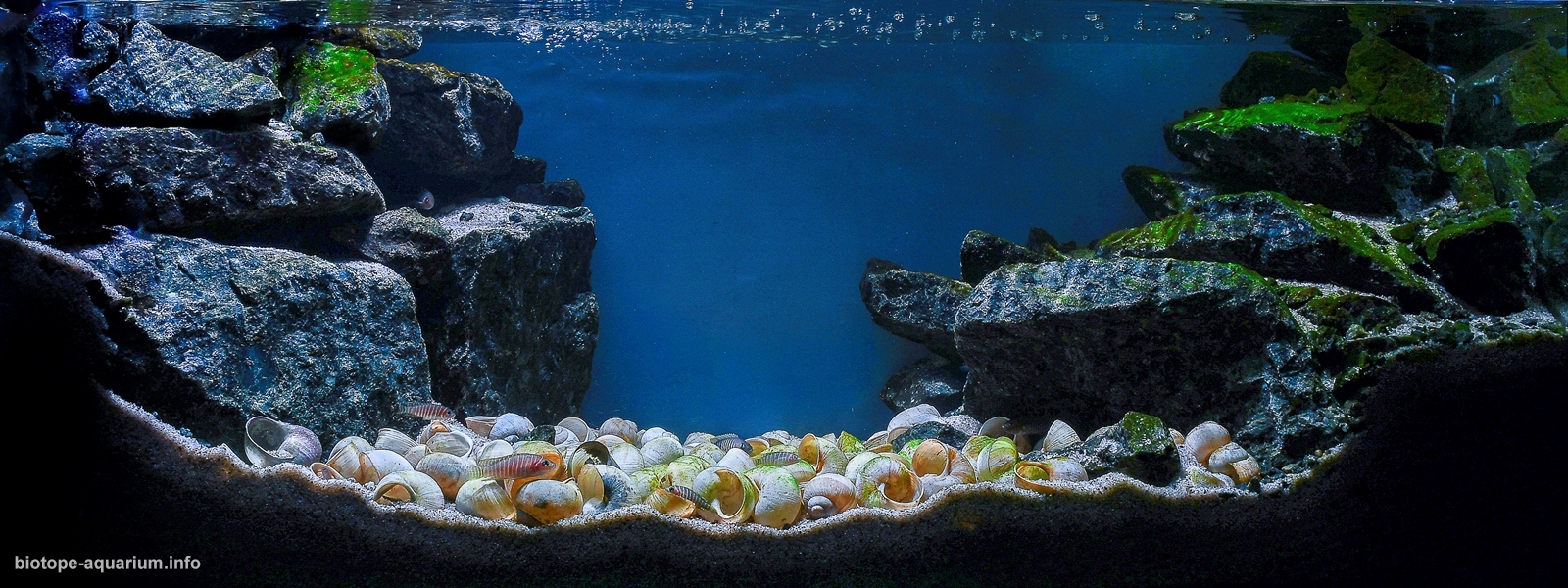Lake Tanganyika, South of Zongwe
_th place in Biotope Aquarium Design Contest 2020

Volume: 120 L
Dimensions: 100*40*30
List of fishes: Lamprologus» similis
List of plants: None
Description of decorations: granite boulders with granite sand fraction 0,2-0,5mm
Description of equipment: Eheim Classic 2213 (plus), 440 L/h.
Lamp Ptero Ray 5950/90-100, 63 Wt
Water parameters: GH: 25
КН: 12
рН от 8,2
t 24C
Additional info: weekly change of twenty percent water
INFORMATION ABOUT BIOTOPE:
Description of the area surrounding the biotope: In the south, in Zambia, you can often see sandy beaches alternating with rocky areas
Description of the underwater landscape of the biotope: shallow water (about 10 meters) in the areas of empty shells of the Tanganyik mollusk Neothauma. In a rocky biotope, with sandy or muddy areas at the base of boulders and stones
Description of the parameters of the habitat: Lake water – the arch of the hole (up to 30 m).
Near the water of the Tanganyka, the pH reaction puddles in the boundaries of 8.0 – 9.5, (pH 9.5 – on the surface of the lake, 8.6 m – at a glybin of 1300 meters). The water conductivity is approximately 609–620 microseconds, the water is good, a little more magnesium salts are added. The initial hardness of water (dGH) in the small parts of the lake and for the data from the small parts of the lake rises in the interval from 12 to 19 degrees and is quite low in terms of salt parts
The temperature of the water in Tanganyika clearly rises behind the balls. So, in the upper ball the temperature is trimmed in the boundaries from 24 ° to 30 ° C, with the decrease in the larger slopes
List of fishes and invertebrates occurring in the nature biotope: The lake has at least 250 species of fish cichlids and undescribed species remain. Almost all (98%) of Tanganyika cichlids are endemic to the lake and thus constitute an important biological resource for the study of speciation in evolution.I will name only a few genera: Altolamprologus, Cyprichromis, Eretmodus, Julidochromis, Lamprologus, Neolamprologus, Tropheus and Xenotilapia
List of plants found in the nature biotope: Vallisneria spiralis, Ceratophyllum demersum, Myriophyllum spicatum и Hydrilla verticillata
Threats to the ecology: The waters of Tanganyika, especially in its northern part, off the coast of Burundi, are constantly dumped with industrial, agricultural and domestic waste. Due to the lack of running water and sewerage, residents of coastal villages often relieve their natural needs directly into the lake, while they take water for domestic needs from the same reservoir. As a result, Burundi regularly experiences outbreaks of infectious diseases, especially cholera.Another problem threatening the Tanganyika ecosystem has recently become the spread of new plant species in the lake. Of these, the greatest danger, according to scientists, is the water hyacinth (lat.Eichhornia crassipes). Growing at a high speed, this plant covers the surface of the lake with a dense carpet, which prevents the access of sunlight, and also disrupts the natural oxygen regime of the reservoir. This leads to the migration or death of organisms living in the lake.
Sources of information: http://www.tanganyika.ru/bio.
http://www.cichlids.ru/
http://www.aquariumhome.narod.
https://uk.wikipedia.org/wiki/
